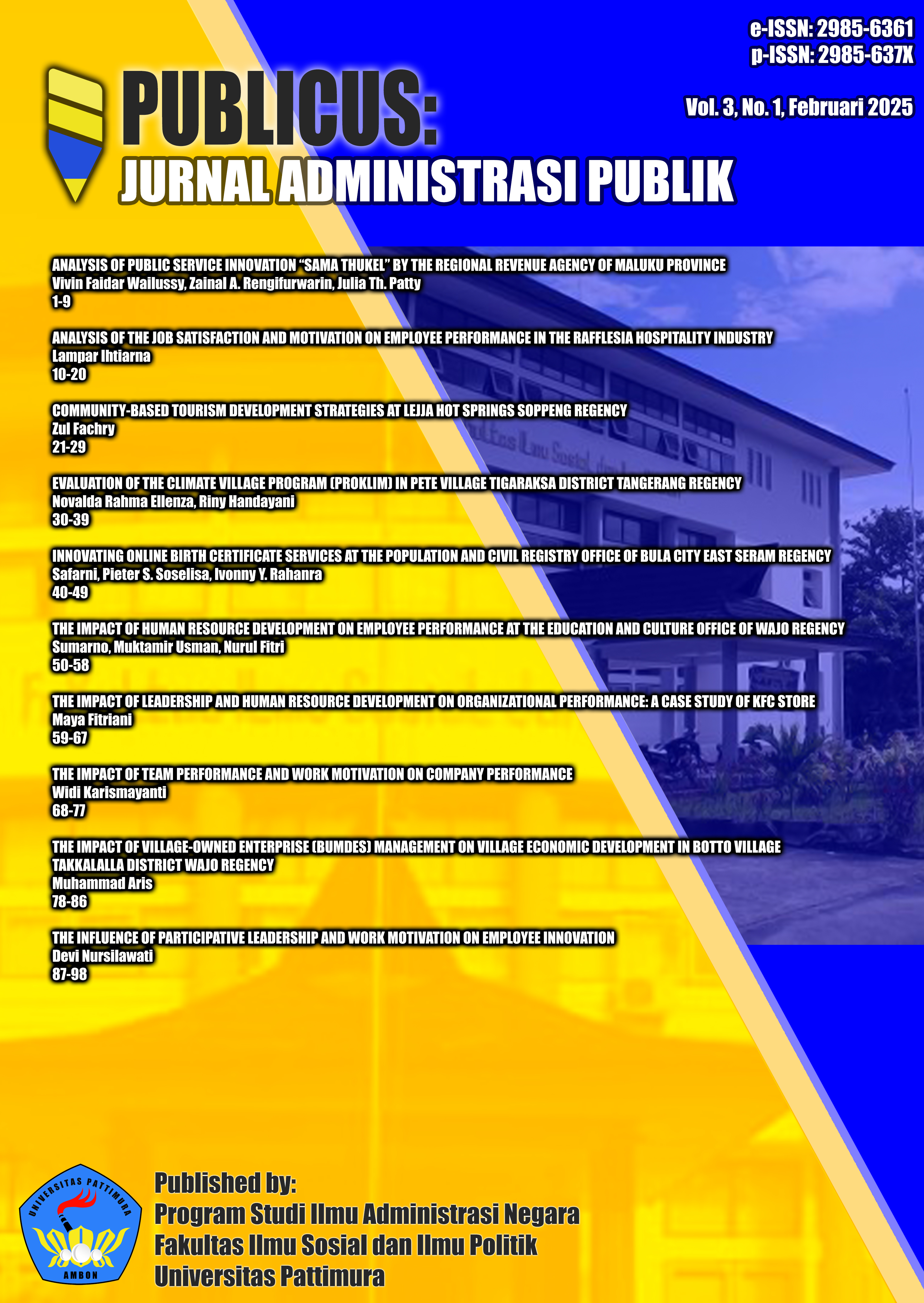The Impact of Human Resource Development on Employee Performance at the Education and Culture Office of Wajo Regency
Abstract
This study aims to examine the impact of human resource development on employee performance at the Education and Culture Office of Wajo Regency. Human resource development refers to the initiatives taken by the organization to enhance employees' skills, knowledge, and capabilities to perform their functions effectively. This research uses a quantitative approach with a survey method. Data were collected through questionnaires distributed to 58 respondents chosen from a population of 139 employees at the Education and Culture Office of Wajo Regency. The results of the analysis show that human resource development has a positive effect on employee performance, contributing 10.6%. Overall, employee performance was rated as very good, while human resource development was rated as good. This study is expected to contribute to designing more effective HRD programs and enhancing employee performance at the Education and Culture Office of Wajo Regency.
Downloads
References
Armstrong, M. (2010). Handbook of Human Resource Management Practice. Kogan Page.
Armstrong, M. (2014). Armstrong's Handbook of Human Resource Management Practice. Kogan Page.
Becker, B. E., & Huselid, M. A. (2006). Strategic Human Resources Management: Where Do We Go from Here?. Journal of Management, 32(6), 898-925.
Becker, G. S. (1964). Human Capital: A Theoretical and Empirical Analysis with Special Reference to Education. University of Chicago Press.
Borman, W. C., & Motowidlo, S. J. (1997). Task performance and contextual performance: The meaning for personnel selection research. Human Performance, 10(2), 99-109.
Bryman, A., & Bell, E. (2015). Business Research Methods. Oxford University Press.
Cascio, W. F. (2015). Managing Human Resources: Productivity, Quality of Work Life, Profits. McGraw-Hill.
DeSimone, R. L., & Harris, D. M. (2014). Human Resource Development. Cengage Learning.
Field, A. (2013). Discovering Statistics Using SPSS. SAGE Publications.
Hollenbeck, J. R., & Williams, C. R. (1986). Training in the public sector: Some implications for human resource management. Public Personnel Management, 15(3), 199-206.
Kraiger, K., McLinden, M. K., & Casper, W. J. (2013). Understanding Training and Development: The Science and Practice of Training. Pearson.
Latham, G. P. (2007). Work Motivation: History, Theory, Research, and Practice. Sage Publications.
Mathis, R. L., & Jackson, J. H. (2016). Human Resource Management. Cengage Learning.
McGregor, D. (1960). The Human Side of Enterprise. McGraw-Hill.
Pallant, J. (2016). SPSS Survival Manual. McGraw-Hill Education.
Pinder, C. C. (2014). Work Motivation in Organizational Behavior. Pearson.
Robinson, D., & Judge, T. A. (2017). Organizational Behavior: Understanding and Managing Life at Work. Pearson.
Sekaran, U., & Bougie, R. (2016). Research Methods for Business: A Skill-Building Approach. Wiley.
Slovin, M. (1960). Formula for Sample Size Determination. Journal of the American Statistical Association, 54(286), 548-556.
Stajkovic, A. D., & Luthans, F. (1997). A meta-analysis of the effects of organizational behavior modification on task performance. Academy of Management Journal, 40(5), 1122-1149.
Copyright (c) 2025 Sumarno Sumarno, Muktamir Usman, Nurul Fitri

This work is licensed under a Creative Commons Attribution 4.0 International License.









